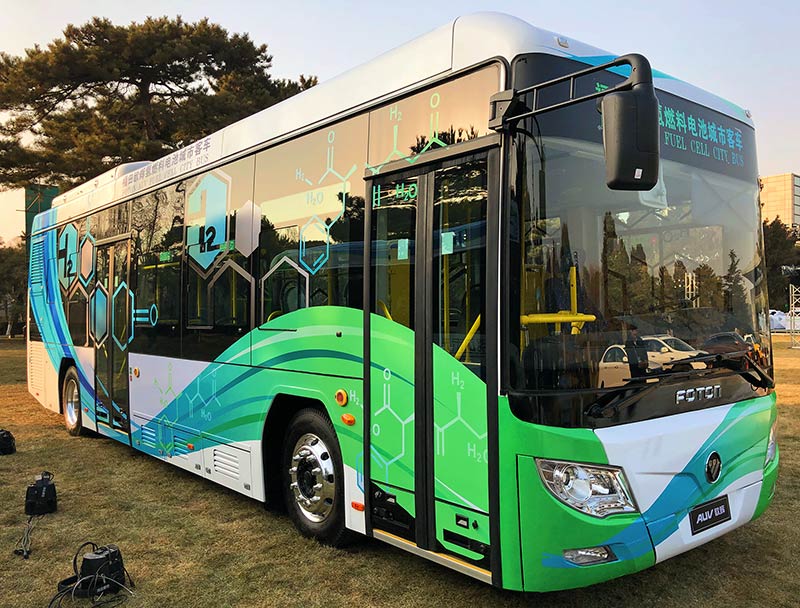In December 2020, New South Wales (NSW) Minister for Transport and Roads, Andrew Constance, announced an accelerated 2030 target for the transition of the NSW Government’s 8,000 strong bus fleet. With buses moving that quick, let’s keep an eye out for Sandra Bullock behind the wheel.
And in May of 2020, a major consortium led by UK-based ITM Power, which claims the world’s largest electrolyser facility, with 1GW per annum manufacturing capacity in Sheffield, England, signed a memorandum of understanding to test and demonstrate the viability of hydrogen fuel-cell electric buses in Australia’s public transport networks.
Dubbed the H2OzBus Project, it intends to initially deploy 100 hydrogen fuel-cell electric buses across up to 10 city hubs in Australia where interest and demand for fuel-cell buses has already been expressed.
It is not yet known how many, if any, hydrogen buses will form part of the NSW fleet transition but Foton Bus Australia and The TrueGreen Mobility Group have this week teamed up to form Foton Mobility Pty Ltd, a new company with the aim of delivering high quality hydrogen powered buses to Australia. Foton Mobility has ambitions to supply NSW and the rest of Australia’s transition bus fleets to hydrogen.
Foton Mobility is launching its line in early 2021, beginning with a 12.5 metre low floor city bus powered by Toyota Fuel cells. The first of these buses is scheduled to arrive in Australia in April. Foton Mobility believes it can produce and deliver up to 200 hydrogen powered city buses to Australia in 2021. Of course, Toyota fuel cells are not necessarily produced with green hydrogen gas.
Foton Mobility CEO, Neil Wang, told pv magazine that their buses can carry approximately 22 kgs of hydrogen gas, giving them a comfortable range of 450 kms in urban driving conditions. “Our buses can be designed to carry more hydrogen onboard which would provide a longer range per charge,” said Wang. “However, in designing the first batch for Australian deployment we have been mindful of the limited hydrogen charging infrastructure so we have designed these buses to get the best range, without needing to install full scale mass hydrogen production facilities.”
“Hydrogen buses have many advantages compared to electric buses,” continued Wang. “A few key benefits are that Hydrogen buses only need 12-15 mins to refuel which is in line with current diesel fuelling time and just one hydrogen fuel station deployed onsite can refuel around 160 buses. Compared to battery electric, recharging 160 electric city bus would need installation of 160 charging stations. Importantly, we can make hydrogen in regional areas which will promote jobs and stimulate local economies.”
Hence why Foton Mobility is also planning the establishment of its own Australian production facility at the TrueGreen Clean-Tech Manufacturing Village in Moss Vale, NSW. The company estimates that it will be locally producing hydrogen buses in Australia by Q2, 2022.
“I believe Hydrogen is the final solution for public transport” said Wang. “Many countries around the world are investing in hydrogen as their future fuel source. In Australia, most states and territories already have a hydrogen road map and excitingly we can now meet the demand from a product side with the release of our high quality, Foton Mobility Hydrogen buses.”
This content is protected by copyright and may not be reused. If you want to cooperate with us and would like to reuse some of our content, please contact: editors@pv-magazine.com.









By submitting this form you agree to pv magazine using your data for the purposes of publishing your comment.
Your personal data will only be disclosed or otherwise transmitted to third parties for the purposes of spam filtering or if this is necessary for technical maintenance of the website. Any other transfer to third parties will not take place unless this is justified on the basis of applicable data protection regulations or if pv magazine is legally obliged to do so.
You may revoke this consent at any time with effect for the future, in which case your personal data will be deleted immediately. Otherwise, your data will be deleted if pv magazine has processed your request or the purpose of data storage is fulfilled.
Further information on data privacy can be found in our Data Protection Policy.